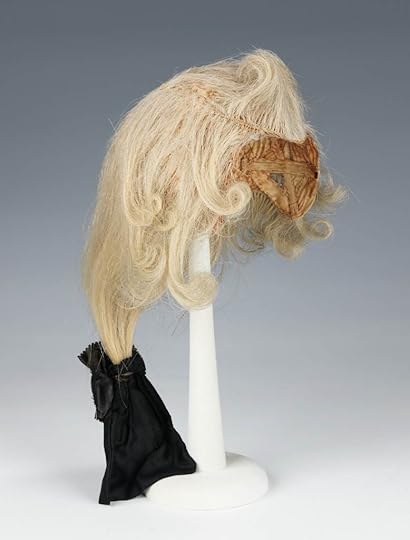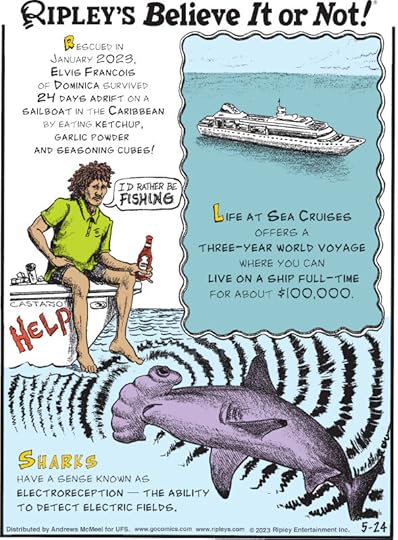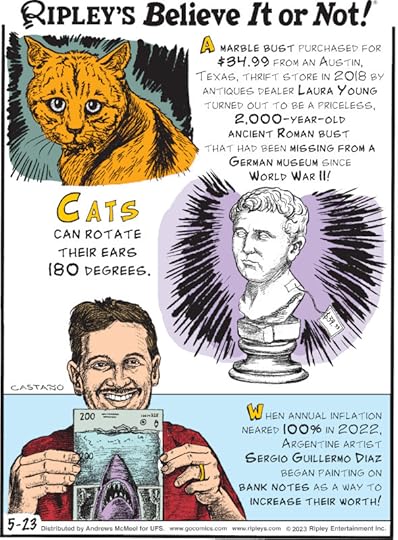Ripley Entertainment Inc.'s Blog, page 25
May 29, 2023
CARTOON 05-29-2023
May 28, 2023
CARTOON 05-28-2023
May 27, 2023
CARTOON 05-27-2023
May 26, 2023
Rare Video Footage Suggests Octopuses May Experience Nightmares
Featured in Ripley's Believe It or Not!

Recent observations made at The Rockefeller University in New York show an octopus potentially experiencing a nightmare. Costello, an Octopus insularis, was filmed several times by postdoctoral researcher Eric Angel Ramos sleeping peacefully and then suddenly thrashing its tentacles, reports Live Science, indicating a sleep disturbance.
Octopi-ing The ThoughtsScientists spent four weeks filming Costello in a laboratory and observed him jolting out of sleep and flailing around on four separate occasions. The footage suggests the cephalopod was experiencing a sleep disorder. The data was posted on bioRxiv but has not been peer reviewed.
The behavior was unusual; however, Costello may not have been experiencing a nightmare. Ramos pointed out that despite all the studies that have been performed on octopuses and cephalopods “there’s still so much we don’t know.”
In two of the four thrashing instances, Costello released black ink into the tank, which octopuses commonly do in the wild for defensive purposes when squared off with a predator.
“It was really bizarre, because it looked like he was in pain; it looked like he might have been suffering, for a moment,” Ramos explained. “And then he just got up like nothing had happened, and he resumed his day as normal.”
The researchers believe Costello “may have been responding to a negative episodic memory or exhibiting a form of parasomnia,” a.k.a., a sleep disorder. They noted that, “While nothing can be concluded rigorously from such data, we share the data and our analysis with the community, in the hope that others will be on the lookout for such rare events.”
Potential ExplanationsLike vertebrates, cephalopods exhibit active and inactive sleep states. In active sleep states, octopuses display camouflage patterns and “modulation of basal rhythms, while remaining relatively unresponsive to outside stimuli.” Some believe these states are comparable to what mammals experience when dreaming.
A 2021 study published in iScience examined the active and quiet sleep patterns of octopuses, which is like humans’ REM and non-REM sleep. Humans experience most of their dreams during REM.
Still, Costello’s behavior was not necessarily a nightmare.
Robyn Crook, a comparative neurobiologist from San Francisco State University who was not involved in The Rockefeller University observations, told Live Science there is simply not enough research about cephalopod sleeping behavior to come to a definitive conclusion. Plus, if octopuses do dream, it may be very different from the way humans dream.
While Costello’s actions are “very interesting,” Crook cautioned that it could have been a result of something else, such as an external stimulus. He may have been startled by something, or he could be in the senescence stage, which occurs right before death when an octopus’s body begins to fail.
Crook and her colleagues have studied senescence in the giant Pacific octopus (Enteroctopus dofleini) and found a link between the condition and nervous system degradation. As a result, Costello’s behavior may be attributed to a lack of motor control instead of a defense mechanism.
It should be noted that Costello, whose life span is 12 to 18 months, died following these observations. Ramos also noted that senescence could be “one of the drivers” of his behavior. He also pointed out that many octopuses in a laboratory are euthanized before senescence occurs, and most labs do not constantly film the animals, so behavior similar to what Costello exhibited may simply not have been noticed.
By Noelle Talmon, contributor for Ripleys.com
EXPLORE THE ODD IN PERSON! Discover hundreds of strange and unusual artifacts and get hands-on with unbelievable interactives when you visit a Ripley’s Odditorium!Source: Rare Video Footage Suggests Octopuses May Experience Nightmares
CARTOON 05-26-2023
May 25, 2023
The Real Reason Why People Wore Powdered Wigs
Featured in Ripley's Believe It or Not!

If you ever look closely at paintings featuring our founding fathers, you’ll notice the fashion at the time included some unique items — white woolen or silk stockings to their knees, a long frock coat, and a wig.
These might seem strange choices today, but wigs were quite the fashion statement back then. They were also a sign that you were part of an elite group of them that could afford them.
We Owe Historical Fashion Wigs to a KingWigs go back to ancient times (the Greeks and Romans sometimes wore them), but their popularity ebbed and flowed throughout the centuries. By the mid-1600s, they were much in vogue again, however — and it was in great part thanks to Louis XIV.
Known as “the dancing Sun King,” Louis XIV was considered a fashion setter. During his youth, he wore his own hair long, but as his hair began to thin, he turned to wigs — he even had his very own royal wigmakers and personal barbers to create the perfect, well-fitting hairpieces.

The wedding of Louis of France in 1697. The wedding of Louis of France, Duke of Burgundy, to Marie-Adélaide of Savoy in 1697. Credit: Antoine Dieu Via Wikimedia Commons.
Soon, wigs became the norm all across royal courts in Europe and eventually moved to America as colonies were established on the East Coast. By the 1700s, wigs were considered “a symbol of wealth, status, authority, even occupation.” The wealthier somebody was, the better the quality of their wig. The truly rich had wigs made with human hair, while those on a tighter budget would have something with horse hair or, even cheaper, goat or yak hair.
There Was Another Reason Wigs Were PopularAnd it was a much less fashionable one.
The 1600s brought a major rise in cases of syphilis in Europe — and some of the most obvious signs of the disease were skin sores, rashes, and patchy hair loss. Bald patches were considered “undignified” and wigs soon became a very practical way of hiding those issues. England’s King Charles II, who was a cousin of Louis XIV, was showing common symptoms of syphilis when he started to wear a wig.
Almost by accident, wigs also solved another common 17th-century problem: lice. Head lice were everywhere in the middle ages and not only did they cause a lot of discomfort but also transmitted a number of diseases (including typhus). But in order for the wig to fit properly, people needed to have their heads shaved off, eliminating the lice problem in the process.
What’s With the “Powdered” Part, Though?Well, this is where things get a bit icky.
King Louis XIV had his own “wig room” at the palace, so he had many wigs available. This gave him a chance to let some “air out” from time to time. Or he could have his personal wigmaker clean them while he wore another one. But most people didn’t have that option, which meant they wore the same one over and over and things often got smelly.

Brooklyn Museum Costume Collection at The Metropolitan Museum of Art, Gift of the Brooklyn Museum, 2009; Caroline A. L. Pratt Fund, 1974
This was the result of many things — including hygiene not being top-notch at the time and the animal fats used to set the wings going rancid over time. Wigs couldn’t be washed either, so the result just wasn’t pretty.
To fight the smell, wigmakers came up with a plan, flour mixed with chalk and kaolin (a type of soft clay) and perfumed with lavender and other essences like cinnamon and amber. As a bonus, the powder would make white wigs (the most expensive kind) even whiter, so they looked brighter and renewed after every “powdering.”
By Diana Bocco, contributor for Ripleys.com
EXPLORE THE ODD IN PERSON! Discover hundreds of strange and unusual artifacts and get hands-on with unbelievable interactives when you visit a Ripley’s Odditorium!CARTOON 05-25-2023
May 24, 2023
The World’s First 3D Printed Rocket Actually Takes Off
Featured in Ripley's Believe It or Not!

Did you know that the 3D printing concept dates back to 1945? Of course, it took a couple of decades for this concept to become a reality. The first forays into producing a true 3D printer began in the 1970s with Johannes F. Gottwald’s patent. The inventor experimented with melted wax, attempting to create a device capable of transforming liquified metal into a solid shape based on a printer’s movement across different layers.
Fast forward to today, and 3D printing has come a long way. It’s also been utilized to create some really weird stuff like unborn babies, other 3D printers, and even spy cameras. (It doesn’t get any more 007 than that!) And this past March, the 3D printing game went next level after the world’s first 3D-printed rocket completed its maiden voyage.
A Launch into the History BooksLet’s face it. There’s been a lot of strange news coming from space over the past few years. Whether we’re talking about SpaceX satellites raining down from the heavens or the role of hamsters in space tourism. Other fascinating stories include a space jellyfish swimming across the sky and space-aged wine selling for $1 million a bottle. And who doesn’t get a kick out of stories about mysterious space radio signals and potential aliens?
View this post on Instagram
A post shared by Relativity Space (@relativityspace)
But there haven’t been many stories combining 3D printing and space exploration as dramatically as the March 22nd launch of Terran 1. Terran 1 has already broken many impressive records. For starters, it’s the first methane-fueled rocket produced in the West to reach space. What’s more, it’s primarily a 3D printer creation!
Space Exploration GamechangerHow much of the rocket did 3D printing produce? According to the company that manufactured it, Relativity, 3D printing accounts for 85 percent of the finished product. What else do you need to know about Terran 1? Stage one of the two-stage rocket includes nine Aeon engines. The second stage has an Aeon vac.
According to Relativity, Terran 1 represents just one portion of a much more rigorous path toward 3D printing success. They hope to one day reach the goal of manufacturing a rocket that’s 95 percent 3D printed. Terran 1 is nothing to sneeze at, though. Before launch, it came in at 110 feet tall and 7.5 feet wide. These stats alone make it the largest 3D-printed object on the planet.
A First of Its Kind Blast OffDespite all the trail blazing, Terran 1 doesn’t fall far from the tree when it comes to things like its engine. In fact, all Relativity engines are 3D printed. They’re also powered by liquid natural gas and liquid oxygen, and Terran 1 is no different.
According to Relativity, these fuels “are not only the best for rocket propulsion, but also for reusability, and the easiest to eventually transition to methane on Mars.” Although 3D printing entire rockets sounds like the stuff of sci-fi movies, potential applications don’t end there.
For example, researchers hope to use 3D printing to surmount the logistical challenges of supplying the international space station with more than 7,000 pounds of spare parts each year. After all, as space exploration moves further from the planet, astronauts won’t have the luxury of supply delivery. But 3D printing what’s needed in space could solve this problem and then some.
How does 3D printing play with gravity? Materials Engineer Tracie Prater doesn’t see a problem, explaining, “Our current hypothesis based on work so far is that this particular 3D printing process is not affected in a significant way by microgravity.” That means a bright future for an odd couple, 3D printing and space exploration.
By Engrid Barnett, contributor for Ripleys.com
EXPLORE THE ODD IN PERSON! Discover hundreds of strange and unusual artifacts and get hands-on with unbelievable interactives when you visit a Ripley’s Odditorium!Source: The World’s First 3D Printed Rocket Actually Takes Off
CARTOON 05-24-2023
May 23, 2023
CARTOON 05-23-2023
Ripley Entertainment Inc.'s Blog
- Ripley Entertainment Inc.'s profile
- 52 followers










